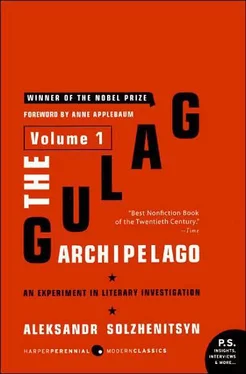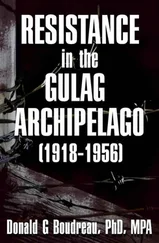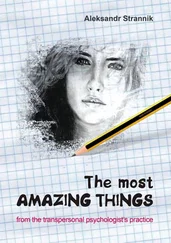And so they shot all of them. But here is how Konstantin Ivanovich Strakhovich, a very important Russian scientist in hydrodynamics, remained alive: Some even higher bigwigs in State Security were dissatisfied because the list was too small and not enough people were being shot. Therefore Strakhovich was selected as a suitable center for uncovering a new organization. He was summoned by Captain Altshuller: “What’s this all about? Did you rush to confess everything so that you’d get shot and thereby conceal the underground government? What was your role in it?” Thus Strakhovich found himself in a new round of interrogations while he remained on death row. He proposed that they consider him the underground Minister of Education. (He wanted to get it over with as soon as possible!) But that wasn’t good enough for Altshuller. The interrogation continued, and by this time Ignatovsky’s group was being executed. During one of the interrogation sessions Strakhovich got angry. It wasn’t that he wanted to live but that he was tired of dying, and, more than anything else, the lies made him sick. And so while he was being cross-questioned in the presence of some Security police bigwig, he pounded on the table: “You are the ones who ought to be shot. I am not going to lie any longer. I take back all my testimony.” And his outburst helped! Not only did they stop interrogating him, but they forgot about him in his death cell for a long time.
In all probability an outburst of desperation in the midst of general submissiveness will always help.
Thus many were shot—thousands at first, then hundreds of thousands. We divide, we multiply, we sigh, we curse. But still and all, these are just numbers. They overwhelm the mind and then are easily forgotten. And if someday the relatives of those who had been shot were to send one publisher photographs of their executed kin, and an album of those photographs were to be published in several volumes, then just by leafing through them and looking into the extinguished eyes we would learn much that would be valuable for the rest of our lives. Such reading, almost without words, would leave a deep mark on our hearts for all eternity.
In one household I am familiar with, where some former zeks live, the following ceremony takes place: On March 5, the day of the death of the Head Murderer, they spread out on the table all the photographs of those who were shot and those who died in camps that they have been able to collect—several dozen of them. And throughout the day solemnity reigns in the apartment—somewhat like that of a church, somewhat like that of a museum. There is funeral music. Friends come to visit, to look at the photographs, to keep silent, to listen, to talk softly together. And then they leave without saying good-bye.
And that is how it ought to be everywhere. At least these deaths would have left a small scar on our hearts.
So that they should not have died in vain!
And I, too, have a few such chance photographs. Look at these at least:
Viktor Petrovich Pokrovsky—shot in Moscow in 1918.
Aleksandr Shtrobinder, a student—shot in Petrograd in 1918.
Vasily Ivanovich Anichkov—shot in the Lubyanka in 1927.
Aleksandr Andreyevich Svechin, a professor of the General Staff—shot in 1935.
Mikhail Aleksandrovich Reformatsky, an agronomist—shot in Orel in 1938.
Yelizaveta Yevgenyevna Anichkova—shot in a camp on the Yenisei in 1942.
How does all that happen? What is it like for people to wait there? What do they feel? What do they think about? And what decisions do they come to? And what is it like when they are taken away? And what do they feel in their last moments? And how, actually, do they… well… do they… ?
The morbid desire to pierce that curtain is natural. (Even though it is, of course, never going to happen to any of us.) And it is natural that those who have survived cannot tell us about the very end—because, after all, they were pardoned.
What happens next is something the executioners know about. But the executioners are not about to talk. (Take, for instance, that famous Uncle Lyosha in the Kresty Prison in Leningrad, who twisted the prisoner’s hands behind his back and put handcuffs on him, and then, if the prisoner shouted down the nighttime corridor, “Farewell, brothers!” crammed a rolled-up rag into his mouth—just why should he tell you about it? He is probably still walking around Leningrad, well dressed. But if you happen to run into him in a beer parlor on the islands or at a soccer game, ask him!)
However, even the executioner doesn’t know about everything right to the very end. While a motor roars its accompaniment, he fires his pistol bullets, unheard, into the back of a head, and he is himself stupidly condemned not to understand what he has done. He doesn’t know about the very end! Only those who have been killed know it all to the very end—and that means no one.
It’s true, however, that the artist, however obliquely and un-clearly, nevertheless knows some part of what happens right up to the actual bullet, the actual noose.
So we are going to construct—from artists and from those who were pardoned—an approximate picture of the death cell. We know, for example, that they do not sleep at night but lie there waiting. That they calm down again only in the morning.
Narokov (Marchenko) in his novel, Imaginary Values , [264]a work much spoiled by the author’s self-assigned task of describing everything as though he were Dostoyevsky, of tearing at the reader’s heartstrings and trying to move him even more than Dostoyevsky, nevertheless in my opinion described the death cell and the scene of the execution itself very well. One cannot verify it, of course, but somehow one believes it.
The interpretations of earlier artists, for example, Leonid Andreyev, seem today somehow to belong willy-nilly to Krylov’s time, a century and a half ago. And for that matter, what fantasist could have imagined the death cells of 1937? Of necessity, he would have woven his psychological threads: what it was like to wait, how the condemned man kept listening, and the like. But who could have foreseen and described such unexpected sensations on the part of prisoners condemned to death as:
1. Prisoners awaiting execution suffered from the cold. They had to sleep on the cement floor under the windows, where it was 28 degrees Fahrenheit. (Strakhovich.) You could freeze to death while you were waiting to be shot.
2. They suffered from being in stuffy, overcrowded cells. Into a cell intended for solitary confinement they would shove seven (never fewer), sometimes ten, fifteen, even twenty-eight prisoners awaiting execution. (Strakhovich in Leningrad, 1942.) And they remained packed in this way for weeks or even months! What kind of nightmare was your seven to be hanged? People in these circumstances don’t think about execution, and it’s not being shot they worry about, but how to move their legs, how to turn over, how to get a gulp of air.
In 1937, when up to forty thousand prisoners were being held at one time in the prisons of Ivanovo—the internal prison of the NKVD, No. 1, No. 2, and the cells for preliminary detention—although they were just barely designed to hold three to four thousand, Prison No. 2 held a mixture of prisoners under interrogation, prisoners condemned to camp, prisoners sentenced to be executed, prisoners whose death sentences had been commuted, and ordinary thieves—and all of them stood for several days so jammed in against each other in one big cell that it was impossible either to raise or lower an arm and those who were shoved up against the bunks could easily break their legs on the edges. It was winter, but in order not to be suffocated the prisoners broke the glass in the windows. (It was in this cell that the old Bolshevik Alalykin, with his snow-white head of hair—he had joined the Party in 1898 and had quit the Party in 1917 after the April Theses—waited for his death sentence to be carried out.)
Читать дальше












